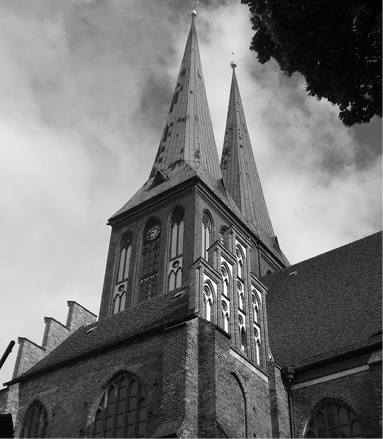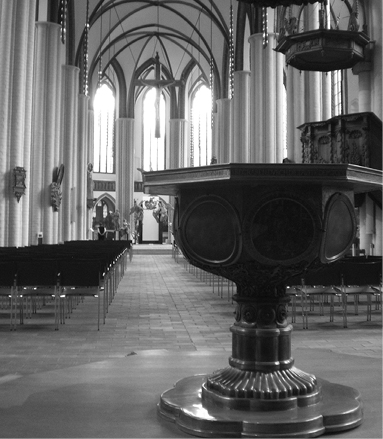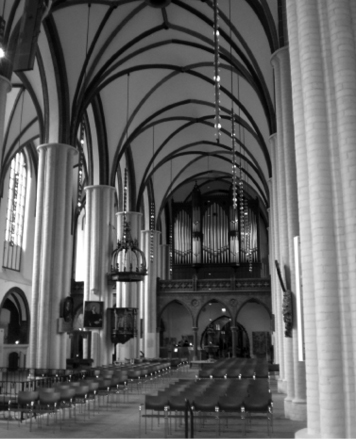A visit to the Nikolai Church, Berlin
A conversation with Albrecht Henkys
As part of the filming for the documentary, “God’s Glory, Neighbor’s Good,” we interviewed Albrecht Henkys, curator of the Nikolai Church in Berlin, Germany, a historic church served by Philipp Jakob Spener, Paul Gerhardt, and Johann Crüger. Interview by Tim Frakes, translated by Dustin L. Smith. May 2015.
Can you tell us about yourself, your work in this historic church building, and its connection to Philipp Jakob Spener?
My name is Albrecht Henkys and I am the curator of the Nikolai Church. During the most recent renovation from 2007 to 2010, I had the chance to add some new comprehensive features and to create new exhibits. After being nearly completely destroyed during the war, the Nikolai Church in Berlin wasn’t rebuilt until the 1980s and only with the resources available at that time. This most recent renovation allowed us to emphasize the medieval period and Reformation era and, at the same time, create a truly comprehensive exhibit.
Philipp Jakob Spener was the pastor of the Nikolai Church and throughout his tenure here was one of the most significant representatives of German Pietism and made the Nikolai Church an important hub for this type of Pietism.

Who is Paul Gerhardt, and how has the Nikolai Church restoration sought to feature his legacy?
I can answer this quite personally because Paul Gerhardt’s music has accompanied me from my early childhood on. My work here at the Nikolai Church has brought me even closer to it. Why do we honor him? Because he’s not only one of the most significant Baroque poets of the German language but also the most significant German hymn writers. We consider it a great pleasure to be able to commemorate Paul Gerhardt here where he did some of his most important work.
Our intention was to honor him and also to make evident in the very church building itself what his tasks and functions were. He wasn’t a full time poet/hymn writer. His primary vocation was as Diakon, that is pastor, and for most of his life was quite intimately connected with Berlin society and this congregation. Looking through the church records, we discovered that Gerhardt’s wife and three children were buried behind the pulpit. In order to provide an emotional access for today’s visitors, we installed modern stone epitaphs in the floor. A pastor like Paul Gerhardt simply would not have had the financial means to commission any kind of headstone or “grave art” for his loved ones; such luxuries were reserved for much richer citizens or members of the court. The only reason we have an epitaph for Johann Crüger is that his son-in-law happened to be a court painter! Paul Gerhardt’s works have in large part to do with his life and also his grieving here, and this we’ve made clear by placing the epitaph stones in the floor.
Can you tell us about Johann Crüger and his career at this church?
Johann Crüger was the cantor of the Nikolai Church. As a very young man he came to Berlin as part of his education, enrolled in the Gymnasium zum Grauen Kloster (the elite high school of Brandenburg), and played an important role in the school choir, which was led by the man whom he would succeed as cantor. After spending two years studying in Wittenberg, he was called back to Berlin in 1622 by the municipal council to hold the most important musical post in Berlin: Nikolai Cantor. He also became a teacher at the Gymnasium zum Grauen Kloster and was called “Berlin’s Director of Music.”
He held both of these positions — which of course grew in importance during his tenure — for over 40 years until his death. The importance of Crüger’s work in combination with that of Paul Gerhardt is such that I can say without lying: this was the first time Berlin wrote European cultural history. The Praxis pietatis melica [“The practice of piety in song,” Crüger’s hymnal from 1647] reached far beyond the Nikolai Church, far beyond the city of Berlin, and even far beyond the country.

How has this church served as a monument and a pilgrimage site over the years?
Reducing this building to nothing but an historical monument would truly be wrong. Many people from around the world come here because of Gerhardt and Crüger. It is interesting that the ruins of the church, truly gruesomely destroyed by the war, were a site of commemoration for Paul Gerhardt and Johann Crüger in the 1950s. Even as rubble, this place was considered important as a site of remembrance for these men and their work and today it is self-evident for us that we should do the same.
I wasn’t sure if the little learning center near the pulpit would actually be used, but I see that it is. The listening stations near the organ, and the reading stations too, they’re being used. I truly get the feeling that it’s not just those people who specifically came here for Gerhardt and Crüger that are being presented with their story and this history; it’s also reaching and informing those who hear the name Gerhardt and think, “I’ve heard of him!” I think it’s become an active part of our exhibition.
What does this music mean for you?
As I mentioned before, I not only grew up with songs, but they have come to mean a great deal to me, emotionally as well, over the years I’ve been working here. Perhaps you’ll be surprised, but I listen to them at home in the evening [laughs] not everyday but somewhat regularly. The songs, they have a brilliant musical and lyrical quality and are truly well suited to appeal to one’s emotions, for example “Nun ruhen alle Wälder” [“Now all the forests are at peace”] and the musical setting by Jakob Hintze. In [our] video we combined various verses and arrangements and it’s something that nearly brings me to tears. [See “Lieder aus der Berliner Nikolaikirche: Nun ruhen alle Wälder,” on YouTube.]
I’d like to add something to the question about why we tell Paul Gerhardt’s and Johann Crüger’s story. Paul Gerhardt lived here in Berlin for quite a long time without a pastorate or adequate pay and he spent a great deal of time with Johann Crüger and the poets who gathered around him. During this time he wrote a number of poems, which later appeared in the Praxis pietatis melica. Because he couldn’t get a job here in Berlin, he went to Mittenwalde as a pastor and it was from there he was called to the Nikolai Church. What I wanted to say is that Berlin and the Nikolai Church can claim Paul Gerhardt for their own because right here was truly a center of his life and work. The Mittenwalders don’t like to hear that, but to be honest he even had his kids baptized here.
We have restructured several liturgical exhibition pieces around places Paul Gerhardt worked. For instance the baptismal font you saw downstairs is the one at which Gerhardt baptized probably hundreds of Berlin children as well as his own. It’s important for me to say that this is not only a musical monument but also a workplace in a very complete sense: a place of life. I’m glad when we can get this across.

How did Spener’s later ministry connect with that of Crüger?
We spoke earlier about hymns and songbooks and it was Spener who, in his later years, heavily influenced the later editions of Praxis pietatis melica. After Crüger’s death, the “town musician” Jakob Hintze took over the songbook and continued publishing it until the 29th or 30th edition.
Hintze, working with Spener, had already put pietistic influences to effective use in the Praxis pietatis melica and later, while working with the pastor of the Nikolai Church, Johann Porst, Spener inspired him to publish the so called Porstsche (“Porst-ian”) Songbook. This songbook was also published for decades to come and played an important role up until the end of the 19th century. In this way, Spener was important here at the Nikolai Church when it comes to hymns and songbooks.
[Scholar] Christian Brunners once said that Paul Gerhardt and Johann Crüger were the Lennon and McCartney of the Baroque era. This is true, because these songs were close to the everyday people; they were so unpretentious that they were whistled down the alley! These weren’t pompous songs for the worship service, they were regular songs for regular people.
